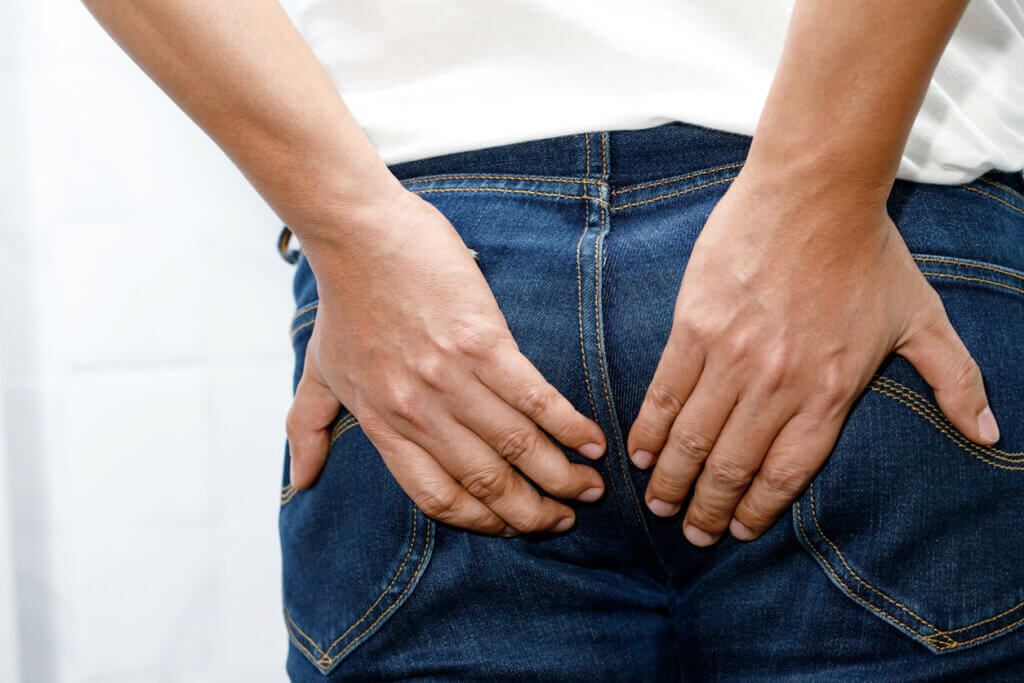Anal Fissures: Everything You Need to Know

Anal injuries are structural problems in the rectal anatomy that often cause great discomfort. These generally include rectal fissures, hemorrhoids, abscesses, and fistulas. Would you like to find out more about anal fissures? Keep reading and we’ll tell you.
An anal fissure is a small tear or crack that occurs on the external surface of the anus. Some studies claim that this is the most common cause of rectal bleeding and severe pain after a bowel movement.
This injury occurs equally in men and women and can affect any age group. However, medical treatment can alleviate symptoms and prevent their recurrence.
Symptoms of anal fissures
The clinical manifestations of anal fissures usually appear during or after defecation and last for several hours. The characteristic symptom is an acute pain of high intensity, and cutting or tearing in nature. Some people define it as the sensation of cutting a sharp object on the skin, which increases with the passage of stools.
On the other hand, research affirms that it’s common to see fresh bright red blood on the toilet paper after cleaning yourself. Other symptoms that may appear in association with an anal fissure are the following:
- An itching or burning in the perianal region
- Translucent or yellow mucus discharge
- A visible crack or lump in the anus

Causes of anal fissures
An anal fissure can be caused by multiple diseases of the digestive tract. In most cases, they’re associated with traumatic events or a person’s own tendency due to weakness or structural anomaly.
In this sense, hard stools and chronic constipation are considered the most frequent triggering agents. On the other hand, irritative and persistent diarrhea, as well as anal sexual practices also increase the probability of suffering from this condition.
The disorder may appear in the following situations:
- Hemorrhoids
- Postpartum pelvic floor weakness
- Chemotherapy treatment
- Syphilis and tuberculosis
- Crohn’s disease and ulcerative colitis
- Amebiasis
These injuries are usually classified according to their time of evolution into acute or chronic. An acute anal fissure is one that appears quickly, is superficial, with clean edges, and a greater tendency to spontaneous healing. On the other hand, the chronic ones have 6 weeks or more of evolution, are deeper, with thick edges and less probability of scarring.
Diagnosis
In most cases, the diagnosis of an anal fissure is made based on the physical examination and the consultation with the doctor. In this sense, the medical history should consider the patient’s pathological history, such as diarrhea and constipation.
During the physical evaluation, the doctor usually instructs the patient to position themselves in the genupectoral or Sims’ position, that is, face down with the knees bent and the chest on the table. In this way, it’s possible to carry out an inspection of the anal region and identify the epithelial wound that the fissure has created. Studies affirm that it’s usually accompanied by a sentinel hemorrhoid in the pectineal line.
A digital rectal examination isn’t usually performed, as it’s usually quite painful and can induce bleeding. However, in the case of a chronic condition, the doctor may request other complementary tests and examinations, such as the following:
- Anoscopy
- Rectosigmoidoscopy
- Blood count and serology
- Fecal studies
- Biopsy
Most anal fissures occur in the posterior area of the anus. However, if they’re found in other areas, then this may point to another pathology, such as inflammatory bowel disease. Similarly, differential diagnosis is vital with painful anal conditions, such as hemorrhoidal thrombosis, perianal abscesses, and colorectal cancer.
Treatment
Acute anal fissures usually resolve quickly with the implementation of general measures to correct constipation and pain. However, most chronic injuries require a specific therapeutic approach or surgery.
General measures are aimed at alleviating symptoms, through small changes in lifestyle, in conjunction with some medications. In this sense, the health professional usually indicates the following recommendations:
- A diet rich in fiber and increased fluid intake.
- Sitz baths with warm or hot water 2 to 3 times a day for 10 to 20 minutes.
- The application of anesthetic ointments or with corticosteroids to reduce pain and itching.
- Consumption of oral analgesics (paracetamol).
- Administration of laxatives to soften the stools.
Nitroglycerin ointments are the most used as a topical treatment, especially when other approaches don’t work. They should be applied 2 to 3 times a day in the anal region, with gloves. They promote blood circulation in the area and the relaxation of the sphincter.
On the other hand, the doctor may also indicate the application of botulinum toxin in the area, with the aim of reducing spasms and relaxing the anal sphincter. However, surgery is often used in cases of severe pain or poor response to treatment. Internal lateral sphincterectomy is usually the surgical method of choice.

Anal fissure prevention is the key
It’s possible to reduce the probability of suffering an anal fissure by means of a careful diet and changes in bowel habits. In this sense, prevention focuses on avoiding constipation and keeping stools soft. For this reason, experts recommend a diet rich in fiber, drinking plenty of water and avoiding delaying bowel movements.
Similarly, you should seek medical attention as soon as possible if severe pain or heavy bleeding occurs – this cannot be delayed. A timely intervention will help to prevent long-term complications.
Anal injuries are structural problems in the rectal anatomy that often cause great discomfort. These generally include rectal fissures, hemorrhoids, abscesses, and fistulas. Would you like to find out more about anal fissures? Keep reading and we’ll tell you.
An anal fissure is a small tear or crack that occurs on the external surface of the anus. Some studies claim that this is the most common cause of rectal bleeding and severe pain after a bowel movement.
This injury occurs equally in men and women and can affect any age group. However, medical treatment can alleviate symptoms and prevent their recurrence.
Symptoms of anal fissures
The clinical manifestations of anal fissures usually appear during or after defecation and last for several hours. The characteristic symptom is an acute pain of high intensity, and cutting or tearing in nature. Some people define it as the sensation of cutting a sharp object on the skin, which increases with the passage of stools.
On the other hand, research affirms that it’s common to see fresh bright red blood on the toilet paper after cleaning yourself. Other symptoms that may appear in association with an anal fissure are the following:
- An itching or burning in the perianal region
- Translucent or yellow mucus discharge
- A visible crack or lump in the anus

Causes of anal fissures
An anal fissure can be caused by multiple diseases of the digestive tract. In most cases, they’re associated with traumatic events or a person’s own tendency due to weakness or structural anomaly.
In this sense, hard stools and chronic constipation are considered the most frequent triggering agents. On the other hand, irritative and persistent diarrhea, as well as anal sexual practices also increase the probability of suffering from this condition.
The disorder may appear in the following situations:
- Hemorrhoids
- Postpartum pelvic floor weakness
- Chemotherapy treatment
- Syphilis and tuberculosis
- Crohn’s disease and ulcerative colitis
- Amebiasis
These injuries are usually classified according to their time of evolution into acute or chronic. An acute anal fissure is one that appears quickly, is superficial, with clean edges, and a greater tendency to spontaneous healing. On the other hand, the chronic ones have 6 weeks or more of evolution, are deeper, with thick edges and less probability of scarring.
Diagnosis
In most cases, the diagnosis of an anal fissure is made based on the physical examination and the consultation with the doctor. In this sense, the medical history should consider the patient’s pathological history, such as diarrhea and constipation.
During the physical evaluation, the doctor usually instructs the patient to position themselves in the genupectoral or Sims’ position, that is, face down with the knees bent and the chest on the table. In this way, it’s possible to carry out an inspection of the anal region and identify the epithelial wound that the fissure has created. Studies affirm that it’s usually accompanied by a sentinel hemorrhoid in the pectineal line.
A digital rectal examination isn’t usually performed, as it’s usually quite painful and can induce bleeding. However, in the case of a chronic condition, the doctor may request other complementary tests and examinations, such as the following:
- Anoscopy
- Rectosigmoidoscopy
- Blood count and serology
- Fecal studies
- Biopsy
Most anal fissures occur in the posterior area of the anus. However, if they’re found in other areas, then this may point to another pathology, such as inflammatory bowel disease. Similarly, differential diagnosis is vital with painful anal conditions, such as hemorrhoidal thrombosis, perianal abscesses, and colorectal cancer.
Treatment
Acute anal fissures usually resolve quickly with the implementation of general measures to correct constipation and pain. However, most chronic injuries require a specific therapeutic approach or surgery.
General measures are aimed at alleviating symptoms, through small changes in lifestyle, in conjunction with some medications. In this sense, the health professional usually indicates the following recommendations:
- A diet rich in fiber and increased fluid intake.
- Sitz baths with warm or hot water 2 to 3 times a day for 10 to 20 minutes.
- The application of anesthetic ointments or with corticosteroids to reduce pain and itching.
- Consumption of oral analgesics (paracetamol).
- Administration of laxatives to soften the stools.
Nitroglycerin ointments are the most used as a topical treatment, especially when other approaches don’t work. They should be applied 2 to 3 times a day in the anal region, with gloves. They promote blood circulation in the area and the relaxation of the sphincter.
On the other hand, the doctor may also indicate the application of botulinum toxin in the area, with the aim of reducing spasms and relaxing the anal sphincter. However, surgery is often used in cases of severe pain or poor response to treatment. Internal lateral sphincterectomy is usually the surgical method of choice.

Anal fissure prevention is the key
It’s possible to reduce the probability of suffering an anal fissure by means of a careful diet and changes in bowel habits. In this sense, prevention focuses on avoiding constipation and keeping stools soft. For this reason, experts recommend a diet rich in fiber, drinking plenty of water and avoiding delaying bowel movements.
Similarly, you should seek medical attention as soon as possible if severe pain or heavy bleeding occurs – this cannot be delayed. A timely intervention will help to prevent long-term complications.
- Martinena Padial E, Pozuelos Estrada J, Fernández Díaz J, Marín Lencero L. Las fisuras anales. Medicina Integral. 2001; 37(4): 170-191.
- Mínguez M, Almela P. Fisura anal. Rev. esp. enferm. dig. 2007; 99( 10 ): 612-612.
- García Gutiérrez A, Villasana Roldós L. Fisura anal: Definición, clasificación, diagnóstico y tratamiento. Rev Cubana Cir. 2008; 47( 1 ).
- Pérez Escobedo S, Jiménez Bobadilla B, Villanueva Herrero J. Factores de riesgo asociados al desarrollo de fístula anal. Cir. gen. 2013; 35( 1 ): 25-31.
- Adamová Z, Slováček R, Bár T, Sankot J et al. Anální fisura [Anal fissure]. Cas Lek Cesk. 2015;154(1):11-3.
- Arroyo A, Montes E, Calderón T, Blesa I et al. Treatment algorithm for anal fissure. Consensus document of the Spanish Association of Coloproctology and the Coloproctology Division of the Spanish Association of Surgeons. Cir Esp (Engl Ed). 2018;96(5):260-267.
Este texto se ofrece únicamente con propósitos informativos y no reemplaza la consulta con un profesional. Ante dudas, consulta a tu especialista.







